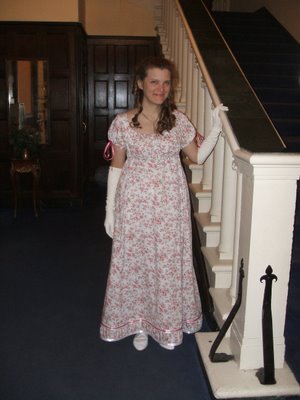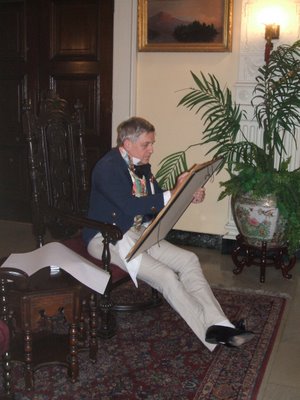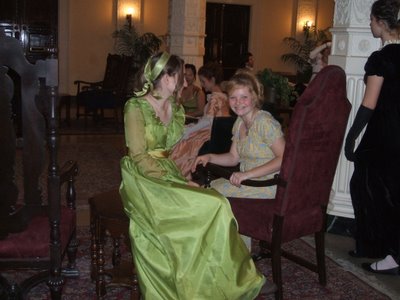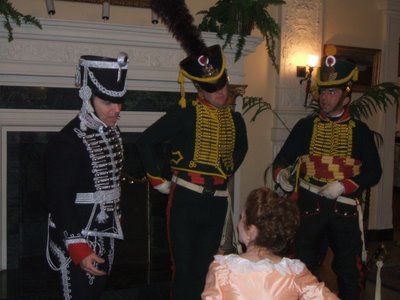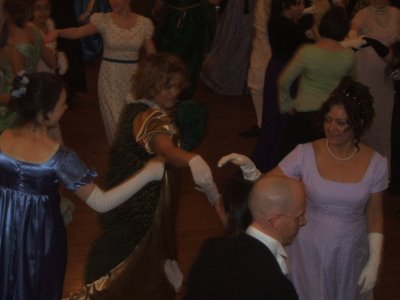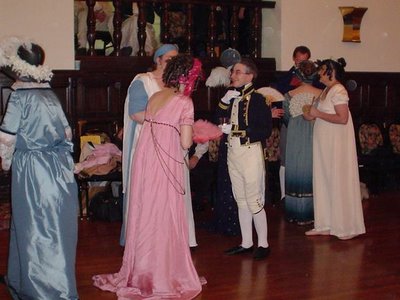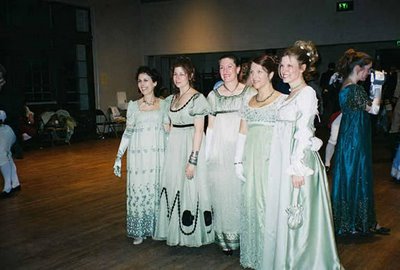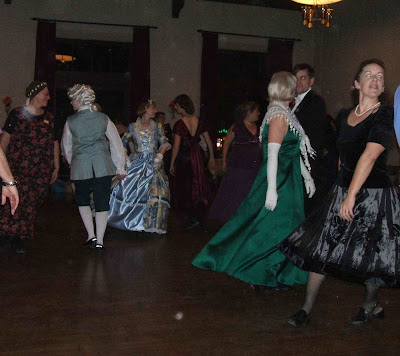 Last Saturday, Todd and I went to the local Playford Ball — four hours of English Country Dance performed by serious English Country Dance fans. Quite exhilirating.
Last Saturday, Todd and I went to the local Playford Ball — four hours of English Country Dance performed by serious English Country Dance fans. Quite exhilirating.
I know a lot of you read my January post on the Jane Austen Ball. (And there’s another Jane Austen Ball coming up in two months! If you plan on going, get your tickets now, because they’re going fast!)
I have now danced at two Playford Balls, and five or so Jane Austen Balls — and there are of course lots of similarities.
 As for differences? From what I’ve seen, the Playford Ball attendees are a bit more likely to be serious about English Country Dance, and the Jane Austen Ball attendees are a bit more likely to be serious about recreating costumes from the period.
As for differences? From what I’ve seen, the Playford Ball attendees are a bit more likely to be serious about English Country Dance, and the Jane Austen Ball attendees are a bit more likely to be serious about recreating costumes from the period.
In other words, you can’t lose either way.
The oldest dance we did at this Playford Ball was “Picking of Sticks,” which appears in John Playford’s first (1651) edition of THE ENGLISH DANCING MASTER. In this book, Playford would give the melody line of a dance, and then all the basic steps.
 Sometimes his directions are clear:
Sometimes his directions are clear:
Leade up all a D. forwards and back. That againe. First man change places with the 2. Wo. then with the last man. Leade up as before, then the Wo. change as the man did, every Cu. doing thus.
(At the beginning of the book, Playford explains that “D” means “Double,” “Wo” stands for “woman,” “We” for women, “2” for “second,” etc…)
Sometimes, however, Playford’s directions are a bit harder to understand:
The two We. at each end leade to each wall, while one man goe up and the other downe, the foure We. meet hands and goe round, men turning S. Goe all as before, men hands and goe round, We. turning single. The men leade the We. at one end to the wall and back, while the other We. goe up on the outside, and come each under the others armes, and turne each other, men turning each a Wo. As much with the other We.
If we go by Jane Austen, folks danced a lot. Which makes perfect sense, really! It warmed you up. It showed off your clothes.
If you were looking for a spouse, it displayed your looks and your health, and gave a chance for flirtation and a bit of touching.
If you already had a spouse, it also gave you a chance for flirtation and a bit of touching — all perfectly proper, dear, I was just doing the dance.
From Northanger Abbey:
The cotillions were over, the country-dancing beginning, and she saw nothing of the Tilneys. “Do not be frightened, my dear Catherine,” whispered Isabella, “but I am really going to dance with your brother again. I declare positively it is quite shocking.”
And later, of course, Tilney and Catherine have the famous exchange:
“I consider a country-dance as an emblem of marriage. Fidelity and complaisance are the principal duties of both; and those men who do not chuse to dance or marry themselves, have no business with the partners or wives of their neighbours.”
“But they are such very different things!”
“–That you think they cannot be compared together.”
“To be sure not. People that marry can never part, but must go and keep house together. People that dance, only stand opposite each other in a long room for half an hour.”
Ah, our dear Catherine…not the sharpest tack in the room, perhaps…
Someone at the ball implied that, in the day, folks who chose not to dance were likely to be thought physically infirm and unmarriageable… Which of course made me think of Mr. Darcy and Mr. Knightley, two gentleman who weren’t great fans of stepping out.
So, questions for today (answer any or all):
1) Was Mr. Knightley (or Darcy) nursing some infirmity in his old age? Will Emma (or Elizabeth) find her husband sadly arthritic?
2) Was Catherine Moreland really that stupid? If so, why did Tilney marry her?
3) Do you think the English language was prettier when we added random “E”s to things, and liked to “goe foure, turne, leade againe”?
4) What do you think of English Country Dance?
All comments welcome!
Cara
author of MY LADY GAMESTER, whiche is fulle of lazy folkes who prefer sittinge and playinge cards to leapinge aboute

